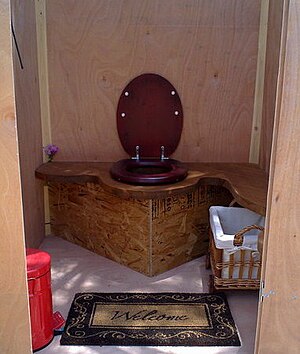| Composting toilet | |
|---|---|
 | |
| Composting toilet at Activism Festival 2010 in the mountains outside Jerusalem | |
| Position in sanitation chain | User interface, collection/treatment (on-site)[1] |
| Application level | Household, neighborhood[1] |
| Management level | Household, public, shared (most common is household level)[1] |
| Inputs | Feces, urine, organics, dry cleansing materials[1] |
| Outputs | Compost, effluent[1] |
| Types | Slow composting (or moldering) toilets, active composters (self-contained), vermifilter toilets |
| Environmental concerns | None[1] |
A composting toilet is a type of dry toilet that treats human waste by a biological process called composting. This process leads to the decomposition of organic matter and turns human waste into compost-like material. Composting is carried out by microorganisms (mainly bacteria and fungi) under controlled aerobic conditions.[2] Most composting toilets use no water for flushing and are therefore called "dry toilets".
In many composting toilet designs, a carbon additive such as sawdust, coconut coir, or peat moss is added after each use. This practice creates air pockets in the human waste to promote aerobic decomposition. This also improves the carbon-to-nitrogen ratio and reduces potential odor. Most composting toilet systems rely on mesophilic composting. Longer retention time in the composting chamber also facilitates pathogen die-off. The end product can also be moved to a secondary system – usually another composting step – to allow more time for mesophilic composting to further reduce pathogens.
Composting toilets, together with the secondary composting step, produce a humus-like end product that can be used to enrich soil if local regulations allow this. Some composting toilets have urine diversion systems in the toilet bowl to collect the urine separately and control excess moisture. A vermifilter toilet is a composting toilet with flushing water where earthworms are used to promote decomposition to compost.
Composting toilets do not require a connection to septic tanks or sewer systems unlike flush toilets.[2] Common applications include national parks, remote holiday cottages, ecotourism resorts, off-grid homes and rural areas in developing countries.